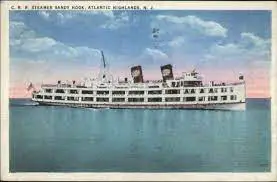The class assignment for the Social Studies Challenge Class of 1985 to write A Child’s History of Atlantic Highlands included 14 stories from the ten member class of 1985. These are some of them as printed in the book published in time for the borough’s centennial in 1987.
Joshua Huddy
Joshua Huddy was captured during the sighting and sentenced to death as a spy. He was hanged from a tree on Bayside Drive.
Steamboats
Atlantic Highlands was once a favorite vacation spot for people from New York. Two steamboats made several round trips daily in season. Passengers disembarked at the great railroad pier built by the Jersey Central in 1892. They could then take the train which ran along the water’s edge to Long Branch, or stay here to enjoy the town beach and the Casino.

The Amphitheater
South of Ocean Boulevard across the street from where the Casino stood is a natural curvature in the earth called thee Amphitheater. Congregations used to gather on the hills surrounding a speaker who stood at the bottom. The acoustics are so marvelous you can hear a whisper as clearly as a shout.
In 1883, President Grant spoke in this amphitheater.
The Sea
In June 1896, two fishermen left Atlantic Highlands on what seemed an impossible journey they would attempt to row 3200 miles across the Atlantic Ocean.
They wanted to win a $10,000 prize offered by a newspaper. Frank Samuelson and George Harbo, Norwegian immigrants had a double ended sea skiff especially designed and built by William Seaman. It was only 18 feet, but had watertight compartments and handrails on the bottom to right here in case she should capsize. They packed a compass, fresh water, canned meat, bread, eggs and a little stove. They took ten pairs of oars and 240 oar locks. They survived 62 days of hard rowing, savage storms, and little sleep, arriving in France in August to great acclaim and praise.
They sailed for home with their boat, “Sea Fox” on a steamer. Due to head winds the steamer ran out of fuel 250 miles from New York. Guess who came to the rescue? That’s right, the Sea Fox! Over the side of the steamer went the little board with her two seamen, who rowed back to New York for assistance.
There is an exact replica of the Sea Fox which may be seen at the Twin Lights Museum in Highlands.

The Argonaut
The Argonaut, Jr. was a submarine built in 1894 by Simon Lake and tested on the bottom of the bay in our own harbor. It was a huge success, crawling around on the sea floor. A “water gate’ or door on the bottom, allowed the occupants to step out. Replica of this tiny but capable craft is located in our harbor.
Sledding on the Hills
Once upon a time and this is a true story, Mount Avenue was a wonderful spot for adults and children to sleigh ride. After a sizeable snowfall, the Police would erect barriers to close each side street, and the people who lived on Mount Avenue would park their cars on the site streets. IN the very long ago days, people made their own sled with wooden runners and a long board seat. When they saw a trolley coming they would cry out “Trolleys coming” and the sledding would stop until the danger was past. A few years ago someone moved the police barrier causing a serious accident, and now this town tradition has been discontinued. Bur our local Historical Society has lots of pictures of folks in their old-fashioned clothes, on their antique sleds, and we can look at them and reminisce.
The Rum Runners
During the days of the Prohibition a large bootlegging operation was going on in Atlantic Highlands. The bootleggers, or “Rum Runners” as they were called, controlled a powerful radio station located at the top of the hill. This station would send out signals to boats to determine whether they were smugglers or Coast Guard patrol boats. If they were smugglers they would open the bridge and allow them to pass through but if they were Coast Guard boats, they weren’t allowed to pass.
During the height of this operation as many as 10.,000 cases a week were smuggled through with a value of between $50 and $100 a case.
The Radar Station
In the 1940s during World War II Bell Labs Researchers needed a site to do secret tests on a new technology called radar. They built a laboratory to house the radar systems while the tests were being done. The antenna was concealed from view by having a water tower built around it as a disguise. No one knew the radar tower was even there! Famous scientists and engineers came here to work and prove how efficient radar could be.
The laboratory has been remodeled into a home and is located on Bayside Drive.